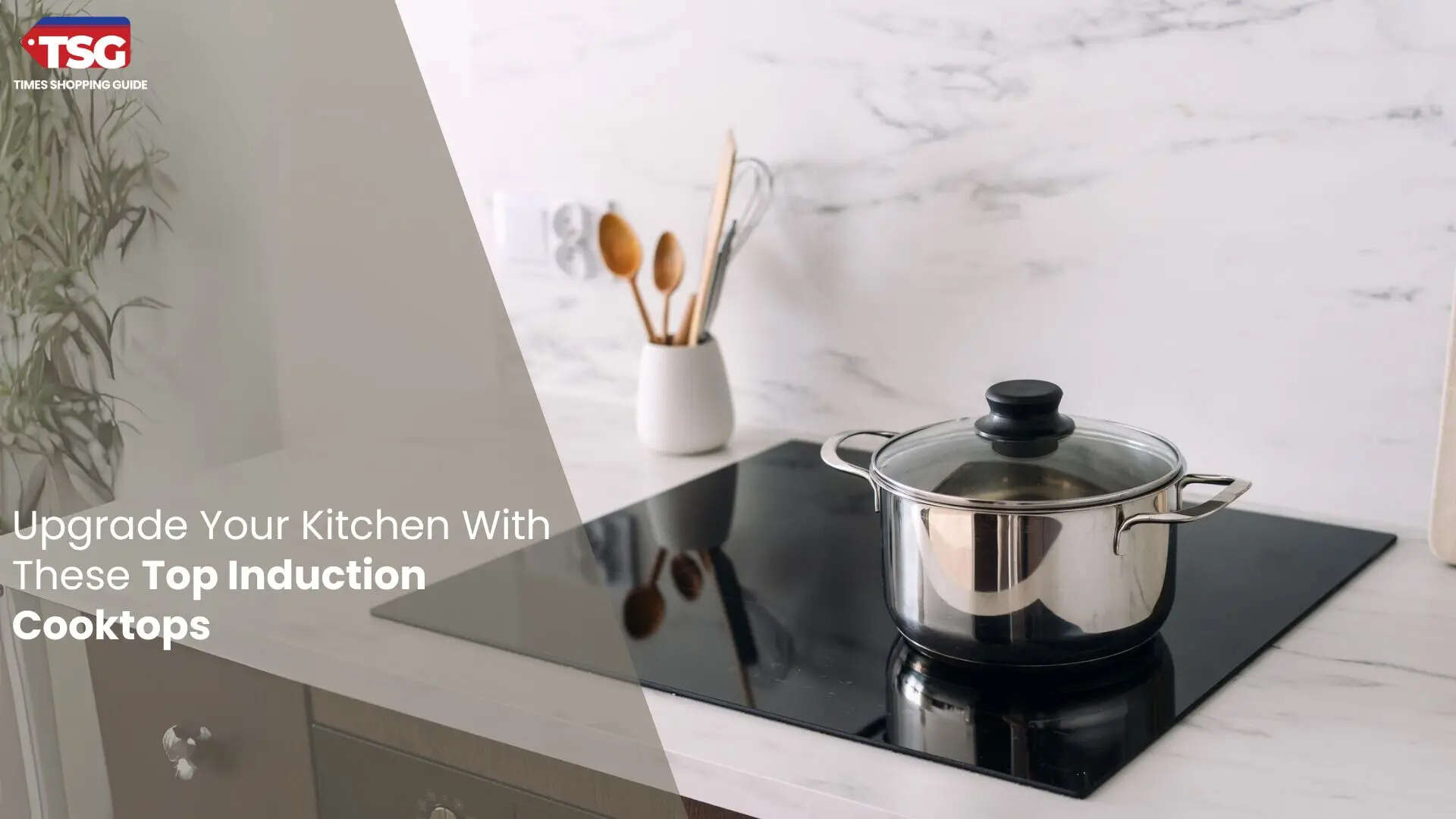- home
- appliances
- kitchen appliances
- buying guide on induction the definitive guide to choose best for your kitchen
Buying Guide on Induction: The Definitive Guide to Choose Best for Your Kitchen
Modern kitchens are incomplete without an induction stove. The mix of safety, convenience, and style is why induction cooktops are replacing traditional gas stoves. Induction cooking revolutionizes the kitchen with its innovative technology. Say goodbye to traditional gas and electric cooktops as you embrace the future of cooking with induction.

Additionally, induction cooktops are renowned for their exceptional energy efficiency. By heating the cookware directly rather than the surrounding air, they minimize heat loss and waste. This feature makes them significantly more efficient than gas or electric cooktops. This not only reduces energy consumption but also translates into lower utility bills, making induction cooking a cost-effective choice in the long run. This guide will help you decide how to choose and purchase the best induction cooktop to heat things up in the kitchen. Let's dive into the essentials of using an induction cooktop and its functionalities.
1. What Is an Induction Cooktop?
Technology has transformed cooking, and one amazing invention is the induction cooktop. Now, you don't have to stress about running out of gas or waiting for a gas cylinder refill. This electric cooking method lets you whip up anything from a simple cup of tea to fancy dishes. In this article, we'll learn about using an induction cooktop and what to remember about its features.
2. How does Induction work?
When you turn on an induction cooktop and place a pot or pan with a magnetic bottom on it, the cooktop's magnetic field induces an electrical current in the cookware. The current generates heat, which then cooks the food inside the pot or pan. The cooktop itself stays relatively cool to the touch as it's not producing heat directly.
3. Types of Induction Cooktops:
a. Built-In Induction:
Built-in induction cooktops are designed to be fitted directly on the kitchen countertop. These cooktops often feature four or more heating components, each of which can be independently controlled. The cooktop is seamlessly blended into the countertop surface, resulting in a sleek and sophisticated appearance. They are perfect for those who want a permanent cooking solution in their kitchen. They come in different sizes, from small ones with two burners to larger ones with six. These cooktops are usually more powerful and have more features than portable ones. For example, Prestige induction cooktops and other top brands offer advanced features like automatic pot detection. This means the cooktop can adjust the heat level automatically based on the size and shape of the pot. Some models even have bridging elements that combine two heating zones to make a bigger cooking area for large pots. Built-in induction cooktops can be paired with wall ovens to create a seamless cooking setup.
b. Portable Induction:
Portable induction cooktops are designed to be moved around and used in various places. They're small, light, and perfect for cramped kitchens, dorms, or camping. Usually, they have one or two heating spots. You can shift them easily, set them up anywhere, and start cooking without any fuss. Plus, no need for a special setup. Also, they're often cheaper than built-in ones, making them a smart choice for budget-conscious buyers.
c. Free-Standing Induction:
Free-standing induction cooktop ranges combine both a cooktop and an oven in one appliance. They're designed to stand on their own, so you can put them anywhere in the kitchen without needing to install them. Typically, they have four or more cooking spots and a full-size oven with various cooking modes. The main perk of free-standing induction ranges is their convenience. They give you everything you need for cooking in a single unit, which is handy if you don't want separate cooktops and ovens. Plus, they offer more features and options for customizing your cooking experience compared to portable units. They come with advanced cooking modes and control settings. However, keep in mind they're usually large and bulky, needing enough space in bigger kitchens.
4. Benefits of Induction Cooktops:
Here, are the key benefits of using induction cooktops are as follow:
a. Energy Efficiency of Induction:
Induction cooktops are incredibly efficient at converting energy into heat. Unlike traditional gas or electric cooktops, which rely on heating elements that heat the air around the cookware, induction cooktops generate heat directly within the cookware itself through electromagnetic induction. This means there is minimal heat loss, resulting in faster cooking times and lower energy consumption.
b. Speed:
One of the most significant advantages of induction cooking is its rapid heating capabilities. Because the heat is generated directly within the cookware, induction cooktops can reach high temperatures almost instantly. This allows for quicker boiling, frying, and searing, making meal preparation faster and more efficient, especially for busy households.
c. Precision Temperature Control:
Induction cooktops offer precise temperature control, allowing users to adjust heat levels with great accuracy. Unlike gas cooktops, which rely on flames that can fluctuate in intensity, or electric cooktops, which may take time to respond to temperature adjustments, induction cooktops provide instant and consistent heat regulation. This precision is essential for delicate cooking tasks that require precise temperature management, such as melting chocolate or simmering sauces.
d. Safe to Use:
Induction cooktops are inherently safer than traditional gas or electric cooktops. Since the heat is generated directly within the cookware, the cooking surface remains relatively cool to the touch, reducing the risk of burns and accidents. Additionally, most induction cooktops are equipped with safety features such as auto-shutoff mechanisms and child lock functions, providing added peace of mind for users, especially those with young children.
e. Easy to Clean:
The smooth, flat surface of induction cooktops makes them incredibly easy to clean. Unlike gas cooktops with grates or electric cooktops with exposed heating elements, induction cooktops have no crevices or recesses where food particles can accumulate. Spills and splatters can be wiped away effortlessly with a damp cloth, making cleanup a breeze.
f. Versatility:
Induction cooktops are compatible with a wide range of cookware materials, including stainless steel, cast iron, and magnetic-bottomed pots and pans. This versatility allows users to use their existing cookware without the need for special adaptations or replacements. Additionally, some induction cooktops feature bridging elements that combine two heating zones to accommodate larger cookware, providing added flexibility for cooking oversized dishes.
g. Environmental Friendliness:
Due to their energy efficiency and precise heating capabilities, induction cooktops are considered environmentally friendly. They reduce energy consumption, resulting in lower greenhouse gas emissions and a smaller carbon footprint compared to gas or electric cooktops. Additionally, induction cooktops eliminate the need for fossil fuels such as natural gas or propane, further reducing their environmental impact.
5. Factors you should consider while selecting an induction cooktop
Factors you should consider while selecting an induction cooktop best suited for your cooking needs:
a. Power and Heating Capacity:
Evaluate the power rating and heating capacity of the induction cooktop to ensure it meets your cooking needs. Higher wattage cooktops offer faster heating and more efficient cooking, making them suitable for boiling water quickly or searing meat at high temperatures. Consider the power levels and heating options available on the cooktop to ensure they align with your cooking preferences and requirements.
b. Size of the Vessel:
For an induction cooktop to work properly, it needs cooking vessels of a specific size that it can recognize. These vessels should measure at least 4 inches across and not exceed 12 to 14 inches. Some cooktops have a handy feature called "element bridging" to handle vessels that don't quite fit these dimensions.
c. Safety Features:
Prioritize safety features when selecting an induction cooktop, especially if you have young children or pets in the household. Look for features such as auto-shutoff mechanisms, child lock functions, and pan detection sensors that automatically turn off the cooktop when cookware is removed. These features help prevent accidents and ensure peace of mind while cooking.
d. Type of Vessel:
Make sure the pots and pans you use on your induction cooktop are suitable. They should be smooth, flat, and magnetic. To check if a pot is magnetic, simply hold a magnet underneath it. The best options are pots made of enamelled cast iron, cast iron, or stainless steel. However, certain types of cooktops, known as converters, can accommodate any material. These converters utilize iron plates placed between the cookware and the induction cooktop to make it compatible.
e. Size of induction:
Assess your kitchen space and cooking requirements to determine the ideal size and configuration of the induction cooktop. Consider the number of cooking zones you need based on the size of your household and the types of dishes you typically prepare. Induction cooktops are available in various sizes, from compact two-burner units to larger six-burner models, so choose one that fits seamlessly into your kitchen layout.
f. Installation Requirements:
Consider the installation requirements of the induction cooktop, including electrical needs and ventilation options. Ensure that your kitchen has the necessary electrical wiring and outlets to accommodate the cooktop's power requirements. Additionally, consider ventilation options such as range hoods or downdraft systems to ensure proper air circulation and safety during cooking.
g. Cookware Compatibility:
Check the compatibility of your existing cookware with the induction cooktop to avoid compatibility issues. Induction cooktops require cookware with magnetic bottoms, such as stainless steel or cast iron, to generate heat through electromagnetic induction. Consider investing in induction-compatible cookware if needed to ensure optimal performance and efficiency.
h. Brand Reputation and Warranty:
Research the reputation of the brand and the warranty offered on the induction cooktop to ensure quality and reliability. Choose reputable brands known for their durable construction, innovative features, and responsive customer support. Additionally, check the warranty coverage and duration to protect your investment and ensure peace of mind in case of any issues or defects.
i. Control and Settings:
Look for induction cooktops with intuitive controls and settings that are easy to use and understand. Consider features such as touch controls, digital displays, and adjustable temperature settings for precise cooking control. Some models also offer advanced features like programmable timers, preset cooking modes, and power boost functions for added convenience and versatility.
Now we have talked about the importance and features of induction cooktops. Let’s check out our top recommendations for the same.
1. Philips Viva Collection HD4928/01 2100-Watt Induction Cooktop, Soft Touch Button with Crystal Glass (Black)
2. Usha Cook Joy (3616) 1600-Watt Induction Cooktop (Black), Sealed, 1 Burner
3. Prestige IRIS ECO 1200 W Induction Cooktop with automatic voltage regulator
4. iBELL IBL30YO Induction Cooktop with Crystal Glass Top, 2000W, Auto Shut Off and Overheat Protection, BIS Certified (Black)
5. Pigeon By Stovekraft 14429 Acer Plus 1800-Watt Induction Cooktop with Feather
Conclusion:
Induction cooktops are becoming increasingly popular in modern homes. You have options like portable, free-standing, and built-in models. They come with many advantages over traditional gas and electric cooktops. They're energy-efficient, quick, and accurate. Plus, they're safe, easy to clean, customizable, and improve air quality. This makes them a great choice for anyone upgrading their cooking setup. If you're thinking of getting one of the top induction cooktops in India, keep these points in mind when choosing.
FAQs:
Are induction cooktops safe to use?
Yes, induction cooktops are generally safe to use. They have features like automatic shut-off and child lock functions for added safety. However, users should still exercise caution and follow safety guidelines while cooking.
How do I clean and maintain an induction cooktop?
Induction cooktops are easy to clean with a damp cloth or non-abrasive cleaner. Regular maintenance involves wiping spills promptly and avoiding abrasive cleaning agents that could damage the surface.
Are induction cooktops more energy-efficient than gas or electric cooktops?
Yes, induction cooktops are generally more energy-efficient because they heat cookware directly, resulting in minimal heat loss. They also offer precise temperature control, further improving energy efficiency.
Disclaimer: Times Shopping Guide is committed to bringing you the latest products from the best brands. Our selection is based on market research and positive consumer feedback. Times Shopping Guide is also a part of an affiliate partnership. In line with this, we may receive a portion of the revenue from your purchases. Please note that the product prices are subject to change based on the retailer's deals.








